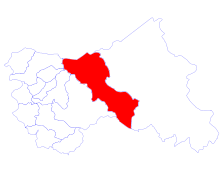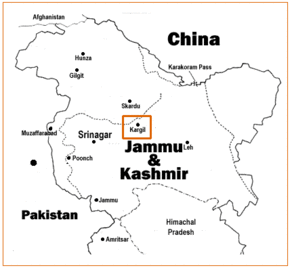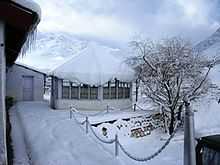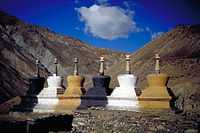Kargil district
| Kargil | |||||||||||||||||||||||||||||
|---|---|---|---|---|---|---|---|---|---|---|---|---|---|---|---|---|---|---|---|---|---|---|---|---|---|---|---|---|---|
| District | |||||||||||||||||||||||||||||
 | |||||||||||||||||||||||||||||
 Kargil | |||||||||||||||||||||||||||||
| Coordinates: 34°01′N 76°24′E / 34.017°N 76.400°ECoordinates: 34°01′N 76°24′E / 34.017°N 76.400°E | |||||||||||||||||||||||||||||
| Country |
| ||||||||||||||||||||||||||||
| State |
| ||||||||||||||||||||||||||||
| District | Kargil | ||||||||||||||||||||||||||||
| Government | |||||||||||||||||||||||||||||
| • Type |
| ||||||||||||||||||||||||||||
| Area | |||||||||||||||||||||||||||||
| • Total | 14,086 km2 (5,439 sq mi) | ||||||||||||||||||||||||||||
| Elevation | 2,676 m (8,780 ft) | ||||||||||||||||||||||||||||
| Population (2011)[1] | |||||||||||||||||||||||||||||
| • Total | 143,388 | ||||||||||||||||||||||||||||
| • Density | 10/km2 (26/sq mi) | ||||||||||||||||||||||||||||
| Languages | |||||||||||||||||||||||||||||
| • Official | Urdu | ||||||||||||||||||||||||||||
| • Spoken | Ladakhi/Pudyig, Hindi/Urdu, Sheena, Balti | ||||||||||||||||||||||||||||
| Time zone | IST (UTC+5:30) | ||||||||||||||||||||||||||||
| PIN Code | 194103 | ||||||||||||||||||||||||||||
| Vehicle registration | JK07 | ||||||||||||||||||||||||||||
| Website | www.kargil.nic.in | ||||||||||||||||||||||||||||


Kargil (Ladakhi: ཀར་གིལ་; Urdu: کرگل ; Hindi: करगिल) is a district of Ladakh region in the Indian state of Jammu and Kashmir. Kargil lies near the Line of Control facing Pakistani-Administered Gilgit–Baltistan to the west, and the mostly Indian-Administered Kashmir valley to the south. Zanskar is part of Kargil district along with Suru, Wakha and Dras valleys.
After the end of the British Raj created India and Pakistan, the Indo-Pakistani War of 1947 over the fate of Kashmir resulted in Pakistani control over Kargil. However, India captured control of Kargil during the Indo-Pakistani War of 1971, which was instigated by the Bangladesh War of Independence. Pakistan attempted to recapture this territory in 1999, but was ultimately defeated by India. Kargil was organised as a separate district in 1979.
As of 2011 it is the least populous district of Jammu and Kashmir (out of 22).[2]
Geography

Kargil district is nestled in the Himalayas, giving it a cool, temperate climate. Summers are warm with cool nights, while winters are long and cold with temperatures often dropping to −40 °C (−40 °F) with recorded temperatures of −60 °C (−76 °F) in the tiny town of Dras, situated some 56 km (35 mi) from the Kargil town. The Zanskar plateau is even colder, making it thus a near-uninhabitable place for humans, except for the hardy Khampas. The entire Kargil district is spread over 14,086 km2 (5,439 sq mi). The Suru River flows through the district.
National Highway 1D, connecting Srinagar to Leh, cuts through Kargil. This highway is typically open for traffic only from June to mid-November due to heavy snowfall at the Zoji La, but in recent years it has been opened before June. Kargil is located 204 km (127 mi) from the capital city of Srinagar. There is a partially paved road—the first 40 kilometres (25 mi) or so—leading from Kargil south to Zanskar. Total distance to Zanskar is nearly 220 km (140 mi), which is again open only from June to September. The region has recently been opening to tourists, with steps a travel hub by the Central Government.[3] Recently, both India and Pakistan have considered linking the Pakistani town of Skardu to Kargil via a bus route to facilitate free movement of Kashmiris in the area.[4]
Demographics

According to the 2011 census Kargil district has a population of 143,388,[2] roughly equal to the nation of Saint Lucia.[5] This gives it a ranking of 603rd in India (out of a total of 640).[2] The district has a population density of 10 inhabitants per square kilometre (26 /sq mi) .[2] Its population growth rate over the decade 2001-2011 was 20.18%.[2] Kargil has a sex ratio of 775 females per every 1000 males,[2] and a literacy rate of 74.49%.[2]
Of total population, 80% are Muslim 95,963, of which 73% follow Shia Islam. Most of the district's Muslims are found in the north (Kargil town, Drass, and the lower Suru valley). Of the remainder, 15% of the total population practise Tibetan Buddhism and Bön, mostly found in Zanskar with small populations in the upper Suru valley (Rangdum) and around Shergol and Mulbekh. Another 5% of the native population follow Hinduism and Sikhism.
Much of Kargil population is inhabited by the Burig and Balti people of Tibetan origin (converting from Buddhism to Islam in the 16th Century) and have intermingled with the Dard, Mon and other Aryan people. The mainly Muslim Dards inhabit the valley of Drass and speak Shina, a small number of Buddhist Dard, known as Brokpa, inhabit the Dha-Hanu region near the Lamayuru monastery. Some Arghons and Shina are also settled in Kargil Town.
Languages
Vernaculars include Balti, written in both the Nastaliq and Devanagari scripts and spoken by over 300,000, mainly in Baltistan.[7]
Culture
Though earlier Tibetan contact has left a profound influence upon the people of both Kargil and Leh, after the spread of Shia Islam the people of Kargil came under heavy influence of Persian culture. This is apparent by the rigorous use of Persian words and phrases in the popular religious as well as other songs called marsias and qasidas. At least until recently, some Kargilis, especially those of the Agha families descendants of Syed preachers who were in a direct line descent from the Prophet Muhammad, were sent to Iraq for their education.[8]Native Ladakhis go for higher Islamic studies in seminarieis in Najaf,Iraq and Qom,Iran. These non-Agah scholars are popularly called as "Shiekh". Some among the most prominent religious scholars include Imam-e-Jummah, Sheikh Mussa Shariefi,Sheikh Ahmed Mohammadi,[9] Shiekh Hussain Zakiri and Shiekh Anwar .[10]
Social ceremonies such as marriages still carry many customs and rituals which are common to both the Muslims and Buddhists. Among the two districts of Ladakh, Kargil has a more mixed ethnic population and thus there are more regional dialects spoken in Kargil as compared to Leh. Local folk songs which are called rgya-glu and balti ghazals are still quite popular and are performed enthusiastically at social gatherings. The J&K tourism ministry annually organises festivals in which various programmes are organised to highlight the culture so as to boost the tourism industry in the district. However, the tourism industry is still undeveloped despite attractive natural as well as rich cultural resources due to bad infrastructure and severe accommodation problems.
History
The name Kargil is said to be derived from the words Khar and rKil. Khar means castle and rKil means centre thus a place between castles as the place lay between many kingdoms. The competing theory is that Kargil has been derived from the words "Gar" and "Khil". Gar in local language mean ‘Anywhere’ and Khil means a central place where people could stay.
Kargil remained relatively obscure right until the Partition of India when the issue of Kashmir became the focal point and resulted in the Indo-Pakistani War of 1947. There were pitched battles fought around Kargil which saw the entire area including Drass and Zoji La Pass initially coming under Pakistan control before most of it being reclaimed by Indian troops by November 1948.[11] It remained with India after the ceasefire. It again saw some action in the Second Kashmir War with India managing to wrest back the reminder of the Kargil area twice. The first capture was on May 17, 1965, when skirmishes broke out in Rann of Kutch, and India retaliated in the Kashmir sector.[11]
However, this had to be returned as per UNMOGIP treatise. On August 15, the same year Kargil fell to Indian forces, though it was once again returned as part of the Tashkent Agreement.[11] However in the Indo-Pakistani War of 1971 the entire Kargil region including key posts was captured by Indian troops under leadership of Col. Chewang Rinchen .[12]
In order to straighten out the line of control in the area, the Indian Army launched night attacks when the ground temperatures sank to below −17°C and about 15 enemy posts located at height of 16,000 feet and more were captured.[13] After Pakistan forces lost the war and agreed to the Shimla Agreement, Kargil and other strategic areas nearby remained with India.[14] Kargil became a separate district in the Ladakh region during the year 1979 when it was bifurcated from the Leh district.
The area shot into the spotlight in spring of 1999, when under a covert plan hatched by the then Army Chief Pervez Musharraf, armed infiltrators from Pakistan, aided by the Pakistani army, occupied vacant high posts belonging to India in the Kargil and Drass regions. The result was a limited scale conflict (Kargil War) between both nuclear equipped nations that ended with India regaining the Kargil region through military power and diplomatic pressure.
Climate
The climate is cold and temperate. The average annual temperature in Kargil is 8.6 °C. About 318 mm of precipitation falls annually.The driest month is November with 6 mm. Most precipitation falls in March, with an average of 82 mm.The warmest month of the year is July with an average temperature of 23.3 °C. In January, the average temperature is -8.8 °C. It is the lowest average temperature of the whole year.The difference in precipitation between the driest month and the wettest month is 76 mm. The average temperatures vary during the year by 32.1 °C.[15]
| Climate data for Kargil, India | |||||||||||||
|---|---|---|---|---|---|---|---|---|---|---|---|---|---|
| Month | Jan | Feb | Mar | Apr | May | Jun | Jul | Aug | Sep | Oct | Nov | Dec | Year |
| Average high °C (°F) | −4.3 (24.3) |
1.6 (34.9) |
4.3 (39.7) |
13.5 (56.3) |
20.9 (69.6) |
25.7 (78.3) |
29.2 (84.6) |
28.6 (83.5) |
24.2 (75.6) |
17.8 (64) |
9.8 (49.6) |
0.9 (33.6) |
14.35 (57.83) |
| Average low °C (°F) | −13.2 (8.2) |
−11.9 (10.6) |
−4.9 (23.2) |
3.3 (37.9) |
9 (48) |
13.3 (55.9) |
17.4 (63.3) |
17 (63) |
12 (54) |
4.9 (40.8) |
−1.6 (29.1) |
−8.1 (17.4) |
3.1 (37.62) |
| Precipitation mm (inches) | 46 (1.81) |
51 (2.01) |
82 (3.23) |
35 (1.38) |
26 (1.02) |
11 (0.43) |
7 (0.28) |
10 (0.39) |
10 (0.39) |
8 (0.31) |
6 (0.24) |
26 (1.02) |
318 (12.51) |
| Source: Climate-Data.org[16] | |||||||||||||
Wildlife


Kargil is home to many endangered wildlife species like snow leopard, Tibetan wolf (Canis lupus langier), Himalayan brown bear (Ursus arctos isabellinus), Asiatic ibex (Capra ibex), Ladakh urial (Ovis vignei vignei), musk deer (Moschus spp.), pikas, Marmots and hares.Asihwarya Maheshwari of the World Wildlife Fund (WWF) is quoted as saying, “It is here in Kargil that one of world’s most elusive creatures, the snow leopard, roams wild and free. During my research I have learnt about the tremendous decline in wildlife sightings since the 1999 Kargil war, so much so that even the common resident birds had disappeared.”[17][18][19] Besides these endangered form of life various species of birds including the black necked Magpie, House Sparrow, Hoopoe,[20] Rosefinches, Red-billed Coughs, Eastern Chiffchaff, Common Sandpiper and European Goldfinches are a common sight in the summers.[21] India Army rears horses, donkeys and mares for transportation purposes.
Administration
Kargil district consists of 9 blocks:
Each block consists of a number of panchayats.
Politics
Kargil District has two assembly constituencies, Zanskar and Kargil.[23] The Member of Parliament from Ladakh region Haji Ghulam Hassan Khan is from Kargil. Major political parties in the region includes National Conference, Congress, PDP, BJP, LUTF(now merged with the BJP) and Kargil Alliance. Fida Hussain (KAS) is the present District Development Commissioner Kargil.[24]
Ladakh Autonomous Hill Council
Ladakh Autonomous Hill Development Council, Kargil (LAHDC-K), set up in the year 2003, is a locally elected body. It consists of Thirty Councilors, Twenty-six of whom are elected from the respective constituencies while Four are nominated from the Principal Minority and Women folk. The Council is headed by The Chief Executive Councilor and has four other Executive Councilors. The Chief Executive Councilor possess the rank and powers of a Cabinet Minister while the Executive Councilors possess the rank and status of Deputy Minister. The 3rd General Election of LAHDC-K was held on the August 22, 2013. [25]Overall voter turnout was 79.65%[26] The election resulted in a hung house at first with the two major parties, Indian National Congress and National Conference, along with their allies the IKMT and the Islamia School Kargil respectively managing to secure 11 seats each. However after the deliberations of the State Coordination Committee, the INC was declared to head the new council.[27] Haji Asgar Ali Karbalai (Indian National Congress) took oath as the new Chief Executive Councillor, LAHDC-Kargil on the 15th September 2013 thus replacing Kacho Ahmad Ali Khan who headed the previous council.
Pictures
-
.jpg)
View of Suru Valley
-

Panorama of Kargil Town
-

Lifeline of Ladakh region- The Zoji La
-

Poyen Village
-

Mesmerizing sunset int the mountains
-

Kargil in Winters
-

The Kun and Nun mountain range in Kargil.
-

Row of Chorten (or Stupa) at the village of Purne. Each of the elements that constitute these edifices, as well as their colour, has a symbolic meaning in Tibetan Buddhism
-

A farmland in Kargil lies straddled below the mountains and above a flowing stream.
Notes
| Wikimedia Commons has media related to Kargil district. |
- ↑ "View Population: Kargil". Office of the Registrar General & Census Commissioner, India. Retrieved 27 March 2012.
- ↑ 2.0 2.1 2.2 2.3 2.4 2.5 2.6 "District Census 2011". Census2011.co.in. 2011. Retrieved 2011-09-30.
- ↑ "Financial Express". Financial Express. 2012-06-12. Retrieved 2013-08-16.
- ↑ Pak considers Kargil-Skardu bus March 15, 2007 NDTV
- ↑ US Directorate of Intelligence. "Country Comparison:Population". Retrieved 2011-10-01. "Saint Lucia 161,557 July 2011 est."
- ↑ "Census of India: District Profile". Censusindia.gov.in. Retrieved 2013-08-16.
- ↑ M. Paul Lewis, ed. (2009). "Balti: A language of Pakistan". Ethnologue: Languages of the World (16th edition ed.). Dallas, Texas: SIL International. Retrieved 2011-09-28.
- ↑ Janet Rizvi. (1996). Ladakh: Crossroads of High Asia. Second Edition, pp. 210-211. Oxford University Press, Delhi. ISBN 0-19-564546-4.
- ↑ Anjuman Jamiatul Ulama Houzai Elmiya Madrasa Asna Asharia Islamia School Kargil
- ↑ IKMT Kargil
- ↑ 11.0 11.1 11.2 Kargil: what might have happened By Javed Hussain October 21, 2006, Dawn
- ↑ Assault on Enemy OPs in Kargil Posts that were returned in 1965 twice occupied again - A dramatized account of India's assault on Kargil during the 71 war hosted on The Liberation Times (a commemorative online newspaper)
- ↑ The Lightning Concept by Major General D.K. Palit (Retd.)
- ↑ The Armed Forces of Pakistan By Pervaiz Iqbal Cheema, Pg 4
- ↑ Climate: Kargil - Climate graph, Temperature graph, Climate table
- ↑ "Climatological Information for Kargil, Ladakh", Hong Kong Observatory, 2003. Web: HKO-Marrakech.
- ↑ "India, Pakistan and the Snow Leopard: Javed Naqi". Kafila. 2012-01-28. Retrieved 2013-08-16.
- ↑ Voices from Frozen Land (2012-01-24). "Javed Naqi: Human-Wildlife Conflict in Kargil: Precipitation of India-Pakistan Rivalry?". Javed-naqi.blogspot.in. Retrieved 2013-08-16.
- ↑ "Human-Wildlife Conflict in Kargil: Precipitation of India-Pakistan Rivalry? | Bargad... बरगद". Bargad.org. 2012-02-01. Retrieved 2013-08-16.
- ↑ "The Indian Encyclopaedia - Google Books". Books.google.co.in. Retrieved 2013-08-16.
- ↑ Alok Bhave (2011-10-06). "Nature watch: Trip to Cold Desert - Ladakh Part2". Alokbhave.blogspot.in. Retrieved 2013-08-16.
- ↑ Statement showing the number of blocks in respect of 22 Districts of Jammu and Kashmir State including newly Created Districts dated 2008-03-13, accessed 2008-08-30
- ↑ "ERO's and AERO's". Chief Electoral Officer, Jammu and Kashmir. Retrieved 2008-08-28.
- ↑ "Profile of Deputy Ccommissioners". Kargil.nic.in. Retrieved 2013-08-16.
- ↑ {{http://kargil.nic.in/election/Council/council_election_2013.htm}}
- ↑ 3rd General LAHDCK Election - 2013
- ↑ Uncertainty looms over Kargil council CEC election - Hindustan Times
Further reading
- Ghulam Mohiuddin Dar. Kargil: Its social, culture, and economic history.
- Kargil : The Important Trade Transit of Yesteryears, People & Society
- Shireen M. Mazari, The Kargil Conflict, 1999: Separating Fact from Fiction, The Institute of Strategic Studies, Islamabad (2003) ISBN 969-8772-00-6
External links
- "District Kargil", Official Kargil Site
- Ladakh Autonomous Hill Development Council, Kargil
- "Pakistan's Northern Areas dilemma", BBC
 |
Bandipore district Ganderbal district Anantnag district |
Disputed region |  | |
| Kishtwar district | |
Leh district | ||
| ||||
| | ||||
| Lahaul and Spiti district, Himachal Pradesh |
| ||||||||||||||||||||